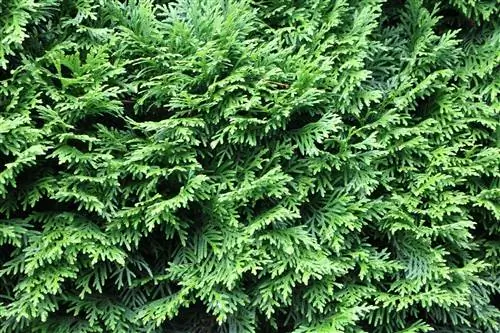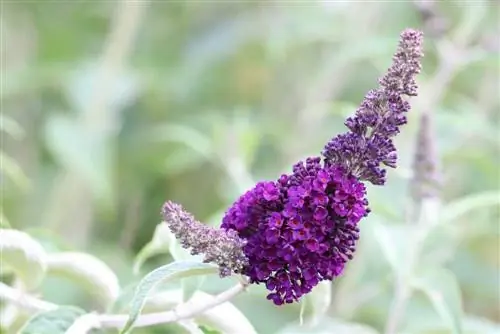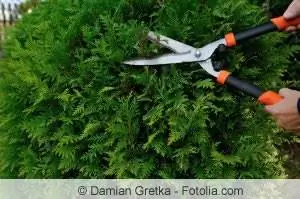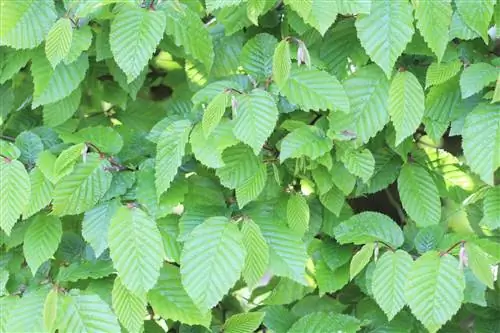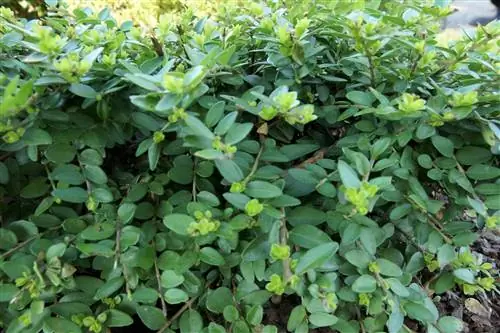- Author admin [email protected].
- Public 2023-12-17 03:39.
- Last modified 2025-01-24 12:45.
In spring, the snow left over from winter melts and severe damage to hedges and various trees is often visible. The upper leaves in particular are dried out and affected. Evergreen species such as viburnum and cherry laurel are particularly affected. In spring the plants should be pruned back and fertilized.
Hedge plants on busy roads
Highly trafficked roads are sprinkled with s alt due to the risk of slippery roads. As a result, hedge plants that are planted directly on streets and sidewalks are particularly badly affected by road s alt. When the frost subsides and the ground is no longer frozen, you should first water the plants very heavily to free the plants from s alt. Once the last s alt residues have been eliminated, the hedges should be stimulated to grow with a special conifer fertilizer.
When the frost-free weather sets in, the shoot spraying can begin. This eliminates pests that have overwintered on the plant and encourages the buds to break open. The applied oil film ensures that the existing pests are suffocated.
Conifer hedges as privacy screens
Most people value their hedges because they offer perfect privacy and ideally separate the garden from the neighboring property. The following plants are particularly popular for this purpose:
- evergreen plants
- Conifers
- Conifers
The popularity of these hedge plants is not only due to the privacy protection, but very dense hedges also offer optimal wind protection, especially in autumn. In addition, vehicle noise can be reduced on busy main roads. The noise from playgrounds and kindergartens can also be dampened accordingly. Thuja is the optimal solution for this purpose.
Thuja hedges are particularly easy to care for and robust. In addition, with a thuja hedge, conifer fertilizer only needs to be added in the year it is planted in order to produce the appropriate growth. The strong natural growth of the plant makes further fertilization unnecessary.
Sprout spraying against insects and deposits
In spring, a shoot spray is required when the buds of ornamental and fruit trees burst. This ensures that eggs and overwintered insects are flushed out of the plants and destroyed. Further prevention measures include ant and caterpillar glue rings on the trunk of the respective plants. This protects hedges and trees from insect pests crawling up from the ground. As soon as the frost has passed, we recommend an organic tree paint, which protects the bark from cracking and preserves its natural elasticity.
After spraying the shoots and taking further precautions against pests, it is advisable to regularly fertilize the trees and hedges. Hedge or conifer fertilizer is just as important as adding compost, mulch or hay to support the natural resistance of the hedge plants. The minerals make the plant resistant to pests, bugs and diseases.
Knock tests make pest infestation visible
The Sitki spruce louse is a very common pest. It can also cause problems for vigorously growing hedges. The risk of an infestation is particularly high after mild winters. The pest is green and has red eyes. It nests inside the plant and overwinters there. Experienced hedge and tree owners therefore carry out individual knock tests in the autumn, which means that the pest can be identified and combated at an early stage. To do this, take a simple white A4 sheet of paper and hold it under a branch that is inside the tree. If more than six pests fall on the leaf while tapping the branch, then the hedge or tree should be treated with appropriate lice treatment.
Evergreen hedges are planted in autumn
Evergreen hedges and plants should also be treated with conifer fertilizer. Ideally, planting takes place in autumn. At this point in time, the best conditions for optimal growth are available. When planting in autumn, you can of course start fertilizing the plants immediately.
The fertilizer used often contains a fungus that attaches to the roots of the plant. The fungus then expands rapidly, causing the roots of the fertilized plant to grow quickly. By artificially enlarging the roots, the plants can absorb significantly more water due to the larger area of the roots. This also results in greater nutrient absorption and stronger and even growth. Conifer fertilizer has a long-term effect, resulting in a continuous improvement in nutrient absorption. Therefore, in most cases, the special fertilizer only needs to be used after planting. In isolated cases, however, fertilization can be carried out once a year. Evergreen plants in particular that are planted in flower pots and pots should be fertilized regularly, as the fertilizer ingredients do not remain in the pot. In general, the plant tells the respective gardener the level of fertilization. If the plant grows little and irregularly, it should be fertilized. If the plant sprouts and thrives sufficiently, the plant receives enough nutrients and does not need to be continually fertilized.
Conifer fertilizer varies greatly in price and composition
There are a few things to consider when buying conifer fertilizer. Helpful information about the composition and price is available on numerous comparison portals on the Internet. In addition, expert gardeners and botanists can provide helpful tips for fertilizing and protecting coniferous plants. In general, not only the price but also the composition is crucial. Some conifer fertilizers contain more nitrogen, others more sulfur. Here it is the plant and not the price that decides which fertilizer is the ideal solution. A pack of conifer fertilizer costs around five euros in stores. This price category is usually sufficient when it comes to conifer fertilizer and should not be exceeded under any circumstances.
What you should know about conifer fertilizer in brief
- Conifer fertilizers often contain a fungus that binds to the plants. Due to the connection and the massive enlargement of the fungus, the surface area of the roots of the plants is also significantly increased.
- The roots can of course absorb significantly more nutrients over a larger surface area, so that the entire plant can be supplied with the important nutrients much better.
- Conifer fertilizer can also have a very long-term effect. Once applied, it ensures a lasting, massive improvement in the nutrient supply of the individual plants and can therefore help them to grow better.
- As a rule, conifer fertilizer and hedge fertilizer only need to be applied when new plants are planted. Sometimes it can also make sense to fertilize a little once a year in order to continue to guarantee the best nutrient supply to the plants.
- Evergreen plants in troughs or planters should also be regularly supplied with conifer fertilizer in order to ensure better growth in the long term.

